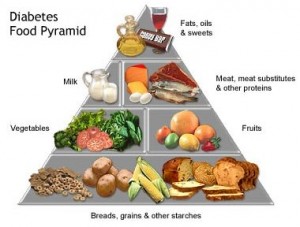
Carbohydrates and proteins affect the blood glucose levels; this is the primary concern when eating foods as a diabetic. You’ll find the major differences in the pyramid are associated with foods like potatoes and grains in place of the grains, beans and other similar starchy vegetables in the vegetables group, and cheese included in the meat instead of the milk group. Also of notable difference is the servings of pasta – which is one third of a cup in the diabetic food pyramid as opposed to the one half cup portion in the United States Department of Agriculture (USDA) Food Guide Pyramid.
Grains and starches are situated at the base of the diabetic food pyramid, and these foods are considered mostly carbohydrates. Bread, cereal, rice, pasta, wheat, rye, oats, potatoes, corn, peas, and dry beans are all in this very starchy group. They are all in this bottom part of the diabetic food pyramid because they have a lot of starchy carbohydrates and they affect the blood glucose in the same way. The recommended serving of the grain and starches category is six to eleven servings daily.
Vegetables are on the next ‘rung’ of the diabetic food pyramid. Because they’re full of naturally occurring vitamins, minerals, and fiber all of them are low in fats. Always try to eat fresh or frozen vegetables that are dark green or deep yellow in color, such as spinach, kale, broccoli, romaine lettuce, carrots, cucumbers, chilies, and peppers. Recommended servings are three to five per day.
Fruits are the next rung of the diabetic food pyramid. Included on this rung are blackberries, grapefruit and tangerines, cantaloupe, strawberries, oranges, apples, bananas, peaches, pears, and apricots. You should have two to four servings of fruit per day.
Next on the diabetic food pyramid is the milk category, because milk products contain a lot of calcium as well as other vitamins. You should try to choose low-fat or nonfat milk items, and you should consume about two to three servings daily.
Meats are next on the food pyramid. Included in this group are beef, chicken, turkey, fish, eggs, tofu, dried beans, cheese, cottage cheese, and peanut butter. Nutritionists generally limit your servings of meat to two to three servings daily.
Finally, the diabetic food pyramid lists sweets, fats, and alcohol. It’s smart for diabetics to avoid these foods altogether, and that’s why they’re at the top of the pyramid. Sugary foods such as candy and cookies can give you quick energy, but aren’t very nutritious and have lots of calories. Consume these items sparingly to avoid huge spikes in your blood glucose.